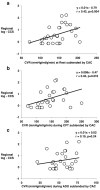Structural alterations of the coronary arterial wall are associated with myocardial flow heterogeneity in type 2 diabetes mellitus
- PMID: 18704406
- PMCID: PMC5016022
- DOI: 10.1007/s00259-008-0885-z
Structural alterations of the coronary arterial wall are associated with myocardial flow heterogeneity in type 2 diabetes mellitus
Abstract
Purpose: To determine the relationship between carotid intima-media thickness (IMT), coronary artery calcification (CAC), and myocardial blood flow (MBF) at rest and during vasomotor stress in type 2 diabetes mellitus (DM).
Methods: In 68 individuals, carotid IMT was measured using high-resolution vascular ultrasound, while the presence of CAC was determined with electron beam tomography (EBT). Global and regional MBF was determined in milliliters per gram per minute with (13)N-ammonia and positron emission tomography (PET) at rest, during cold pressor testing (CPT), and during adenosine (ADO) stimulation.
Results: There was neither a relationship between carotid IMT and CAC (r = 0.10, p = 0.32) nor between carotid IMT and coronary circulatory function in response to CPT and during ADO (r = -0.18, p = 0.25 and r = 0.10, p = 0.54, respectively). In 33 individuals, EBT detected CAC with a mean Agatston-derived calcium score of 44 +/- 18. There was a significant difference in regional MBFs between territories with and without CAC at rest and during ADO-stimulated hyperemia (0.69 +/- 0.24 vs. 0.74 +/- 0.23 and 1.82 +/- 0.50 vs. 1.95 +/- 0.51 ml/g/min; p < or = 0.05, respectively) and also during CPT in DM but less pronounced (0.81 +/- 0.24 vs. 0.83 +/- 0.23 ml/g/min; p = ns). The increase in CAC was paralleled with a progressive regional decrease in resting as well as in CPT- and ADO-related MBFs (r = -0.36, p < or = 0.014; r = -0.46, p < or = 0.007; and r = -0.33, p < or = 0.041, respectively).
Conclusions: The absence of any correlation between carotid IMT and coronary circulatory function in type 2 DM suggests different features and stages of early atherosclerosis in the peripheral and coronary circulation. PET-measured MBF heterogeneity at rest and during vasomotor stress may reflect downstream fluid dynamic effects of coronary artery disease (CAD)-related early structural alterations of the arterial wall.
Figures



Similar articles
-
Improvement in coronary endothelial function is independently associated with a slowed progression of coronary artery calcification in type 2 diabetes mellitus.Eur Heart J. 2009 Dec;30(24):3064-73. doi: 10.1093/eurheartj/ehp482. Eur Heart J. 2009. PMID: 19914919 Free PMC article.
-
PET-measured heterogeneity in longitudinal myocardial blood flow in response to sympathetic and pharmacologic stress as a non-invasive probe of epicardial vasomotor dysfunction.Eur J Nucl Med Mol Imaging. 2006 Oct;33(10):1140-9. doi: 10.1007/s00259-006-0069-7. Epub 2006 Apr 26. Eur J Nucl Med Mol Imaging. 2006. PMID: 16639609
-
Effect of type 2 diabetes mellitus on epicardial adipose tissue volume and coronary vasomotor function.Am J Cardiol. 2014 Jan 1;113(1):90-7. doi: 10.1016/j.amjcard.2013.09.022. Epub 2013 Oct 3. Am J Cardiol. 2014. PMID: 24169015
-
Cardiac PET imaging for the detection and monitoring of coronary artery disease and microvascular health.JACC Cardiovasc Imaging. 2010 Jun;3(6):623-40. doi: 10.1016/j.jcmg.2010.04.007. JACC Cardiovasc Imaging. 2010. PMID: 20541718 Review.
-
Pathology of Human Coronary and Carotid Artery Atherosclerosis and Vascular Calcification in Diabetes Mellitus.Arterioscler Thromb Vasc Biol. 2017 Feb;37(2):191-204. doi: 10.1161/ATVBAHA.116.306256. Epub 2016 Dec 1. Arterioscler Thromb Vasc Biol. 2017. PMID: 27908890 Free PMC article. Review.
Cited by
-
The influence of insulin resistance, obesity, and diabetes mellitus on vascular tone and myocardial blood flow.Curr Cardiol Rep. 2012 Apr;14(2):217-25. doi: 10.1007/s11886-011-0240-z. Curr Cardiol Rep. 2012. PMID: 22205177 Review.
-
Positron Emission Tomography in the Diagnosis and Management of Coronary Artery Disease.Medicina (Kaunas). 2018 Jul 11;54(3):47. doi: 10.3390/medicina54030047. Medicina (Kaunas). 2018. PMID: 30344278 Free PMC article. Review.
-
Functional or structural impairment of flow-mediated epicardial vasodilation may precede coronary microvascular dysfunction.Int J Cardiol Heart Vasc. 2025 Jan 9;56:101606. doi: 10.1016/j.ijcha.2025.101606. eCollection 2025 Feb. Int J Cardiol Heart Vasc. 2025. PMID: 39963577 Free PMC article.
-
Coronary Pathophysiology Underlying the Obesity Paradox.JACC Adv. 2024 Apr 10;3(5):100933. doi: 10.1016/j.jacadv.2024.100933. eCollection 2024 May. JACC Adv. 2024. PMID: 38939635 Free PMC article.
-
PET-measured longitudinal flow gradient correlates with invasive fractional flow reserve in CAD patients.Eur Heart J Cardiovasc Imaging. 2017 May 1;18(5):538-548. doi: 10.1093/ehjci/jew116. Eur Heart J Cardiovasc Imaging. 2017. PMID: 27325812 Free PMC article.
References
-
- Di Carli MF, Hachamovitch R. New technology for noninvasive evaluation of coronary artery disease. Circulation. 2007;115:1464–80. - PubMed
-
- Reddy KG, Nair RN, Sheehan HM, Hodgson JM. Evidence that selective endothelial dysfunction may occur in the absence of angiographic or ultrasound atherosclerosis in patients with risk factors for atherosclerosis. J Am Coll Cardiol. 1994;23:833–43. - PubMed
-
- Schindler TH, Cardenas J, Prior JO, Facta AD, Kreissl MC, Zhang XL, et al. Relationship between increasing body weight, insulin resistance, inflammation, adipocytokine leptin, and coronary circulatory function. J Am Coll Cardiol. 2006;47:1188–95. - PubMed
-
- Di Carli MF, Dorbala S, Hachamovitch R. Integrated cardiac PET-CT for the diagnosis and management of CAD. J Nucl Cardiol. 2006;13:139–44. - PubMed
Publication types
MeSH terms
Substances
Grants and funding
LinkOut - more resources
Full Text Sources
Medical
Miscellaneous

